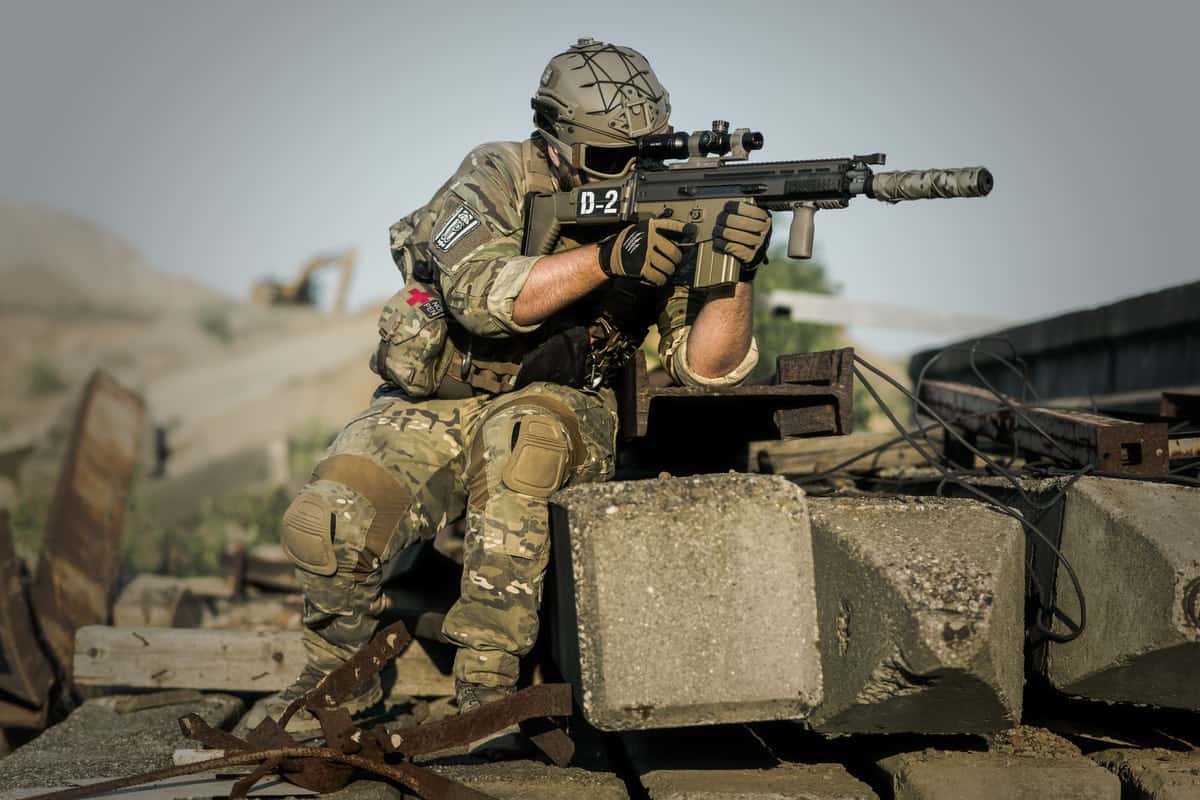MARSOC Vs. Green Beret: All You Need To Know
Share
The United States of America is a great country in diverse aspects. It’s unarguably the most powerful nation on the planet.
America reportedly has the world’s biggest military budget. And the country’s overall military power is the best in the world.
However, America’s Special Forces are quite diverse. So you may end up getting confused trying to figure out what each group is. MARSOC and Green Beret are just two of the various groups under SOCOM (Special Operations Command). And these two have been battling for superiority since MARSOC came into the fold.
This post looks at MARSOC vs. Green Beret’s comparison. After reading it, you should be able to make an informed decision.
MARSOC Vs. Green Beret Establishment
The formation of more units under the special operations command was to boost the United States of America’s chances of successfully combating threats within and outside its territory.
MARSOC and Green Beret are two special force units that have made the country proud on the battlefront. The two groups’ experience and knowledge has been an asset to the U.S Special Operations Command.
So what is MARSOC? Many confuse MARSOC to Naval Seal. But they’re not. However, MARSOC wears the same military fatigue as marine infantrymen. It’s a unit formed by the U.S. Marine. Members of the team also come from the Marine.
MARSOC (Marine Special Operations Command) is colloquially called Marine Raiders.
The next security outfit is the Green Beret, which refers to themselves as the “quiet professionals.” Unlike MARSOC, members of the Green Beret are drawn from U.S Army.
The Green Beret is also called Army Special Force. They may call themselves “quiet professionals” but are a big threat to enemies of all proportions on the battlefield.
Age-wise, the Green Beret is older than MARSOC. MARSOC’s formation all began in 2005 when the then secretary of defense directed the U.S. Marine to create a special operations unit.
MARSOC was officially born in 2006. And since then, the unit hasn’t shown any sign of slowing down. This special operations unit has contributed immensely to the country’s wealth of knowledge on irregular warfare.
On the contrary, the Army Special forces, aka the Green Beret, was formed in 1952 by President John F. Kennedy. His primary objective was to enhance the department of defense’s strength in the fight against terrorism and unconventional wars.
So, the Green Beret got formed long before MARSOC came into existence. But these two groups have been impressive on the battlefront.
The Green Berets are on the front lines defending our country. These elite warriors have undergone layers of selection and training before they can wear these green berets and become heroes of the country. We can honor these heroes in our own way. In U.S. military culture, military challenge coins are awarded on many anniversaries or occasions. Challenge coins are a symbol of honor and reward. We can customize challenge coins with their name or likeness. They would be the perfect gift for a soon-to-be, current, or retired military member. See more challenge coins at gs-jj.com.
MARSOC Vs. Green Beret Training: What You Need To Know
The kind of training exercises people undergo before joining the U.S. Special Forces is shocking. Not everyone that starts the assessment in either MARSOC or Green Beret makes it to the next stage.
However, you can’t blame the Marine or Army for using such rigorous and highly-demanding physical and mental exercises to test wannabe MARSOC or Green Beret candidates.
The harsh training is to take candidates through similar experiences they may face on the battleground. In reality, the condition one may experience on the battlefield could even be harsher. So it’s better to adapt during training than on the battlefield.
MARSOC and Green Beret’s training for prospects is tough. Many candidates give up interest after spending a few weeks in camp.
So, let no one deceive you; MARSOC and Green Beret’s training for new intakes is tough to the teeth. You have to be ready physically, mentally, and otherwise.
Joining the Army Special Forces, aka the Green Beret, is one of the toughest you will ever encounter. Before you can start the unit’s qualification course, you must spend a compulsory 24 days on camp.
During the 24 days, there will be intense training to see if you’re strong enough physically, mentally and otherwise, to join the unit.
Unfortunately, many don’t make it past the 24 days assessment. Those who get the nod can start the qualification course.
So, no one is trying to scare prospects by emphasizing how tough getting into the Green Beret is. It’s the reality of things.
For example, in 2019 alone, 3000 prospects entered the assessment phase. But do you know that only 936 of them got qualified to move to the next stage? That’s it. On the final day of graduation, only 70% made it into Green Beret.
Now, here’s a simple breakdown. After finishing your SFAS (Special Forces Assessment and Selection), you can then start the Q-Course. And depending on your occupational specialty, the course could last 6 to 12 months.
Courses on communication and medication
Green Beret’s SFAS lasts for 24 days. And its training is centered on long-distance navigation, among others.
Unlike MARSOC, you don’t have to be dive qualified to join Green Beret. But during your training’s first physical phase, swimming, run an obstacle, push-ups, pull-ups, and sit-ups are essential.
MARSOC’s training is quite similar to Green Beret’s. But keep in mind that Raiders are selected from the U.S. Marine.
Therefore, prospects must join the U.S. marine for 3years and excel before going to MARSOC. There’s a high probability that you would get deployed once or more times after spending this much time in the Marines.
MARSOC assessment course has two phases. The first phase lasts for three weeks and highly physically challenging. You may likely question your desire to continue after going through this phase.
A Handy Tip: If you can ruck competitively, swim, and be able to tread while wearing your uniform, you have higher chances of progressing to the next stage.
You will move into phase 2 after passing phase 1. And keep in mind that this phase is more physically draining and challenging than the first phase. Here, MARSOC will test your mentality and tactical ability.
After passing phase 2, shortlisted candidates can start the individual training course (ITC), which lasts for 9 months. Here, candidates learn marine-specific skills and go through other crucial combat-ready training.
Some of the training includes communication, sniper, diving, intelligence, foreign weapons, and language training.
After completing your ITC, you can join the Marine Raider Battalion and start participating in tactical operations.
MARSOC members include seasoned Marines with 3 or more years in service. The majority of the candidates have seen combat or have been deployed once or more.
Civilians can join but need to join the Marine Corps first and spend some time there before applying to MARSOC’s phase 1 assessment course.
A Handy Tip: Marines that wish to join MARSOC need to pass its swimming test. Furthermore, the candidate’s least ASVAB General Technical score should be at least 105. Physical fitness score must be excellent, and you must obtain a secret clearance.
How Often MARSOC And Green Beret Deploys
Being in the Special Forces shouldn’t prevent you from living like every ordinary civilian. MARSOC and Green Beret deploy their fighters for tactical missions now and then, but they do so in cycles. The reason is to give their members a chance to be civilians and Special Forces simultaneously.
MARSOC and Green Beret have flexible deployments. They have also been able to rotate unit members effectively.
MARSOC’s deployment cycle is from 90 days to 8 months.
As for Green Beret, deployment is once in every 2 to 3 years for 6 to 15 months.
MARSOC And Green Beret Age Limit
Age is one major problem preventing many people from joining their preferred security outfit. So it’s an issue worth discussing.
However, joining MARSOC might be more visible for many, as there are no age limits. As long as you’re an adult and meet other requirements, you’re welcome to join.
But things are a little bit stricter in Green Beret’s camp. Besides having a minimum E-3 rank, candidates must not be below 20 years. The maximum age is 36 years.
So, now you know why MARSOC members are a bit older than Green Beret’s.
Duties of Green Beret Vs. MARSOC
The U.S. Marine created MARSOC so it can participate on the battlefield when the need arises.
So, what does MARSOC do?
- Direct action
- Counterterrorism
- Counterinsurgency
- Special reconnaissance
- Security force assistance
- Foreign internal defense
- Preparation of the environment
What does the Green Beret do?
- Direct action
- Unconventional warfare
- Foreign internal defense
- Counterterrorism
- Counterinsurgency
- Information operations
- Security force assistance
- Special reconnaissance
- Counterproliferation of weapon of mass destruction
You can see that the Green Beret Nis deployed to execute more missions than MARSOC. They get deployed to execute nine doctrinal missions.
Conclusion
Both MARSOC and Green Beret have made the country proud. They fight to keep citizens of the U.S. safe and uphold the reputation of the country.
MARSOC and Green Beret are quite difficult to join, with the latter being the hardest. And both units are under the Special Operations Command (SOCOM).
So, now you know the difference between MARSOC and Green Beret. You can even tell the similarities between both units based on their mission and training activities.


















